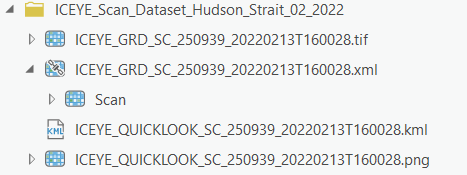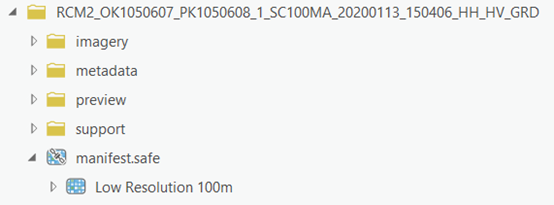There are many synthetic aperture radar (SAR) sensor types available, and each has various product types and polarizations. Through active sensing, SAR satellites function day and night.
ICEYE
ICEYE is a high-resolution SAR commercial microsatellite constellation. The X-band sensor operates at a center frequency of 9.65 GHz (wavelength of approximately 3.1 centimeters). The satellites collect data in three imaging modes: Stripmap (SM), Spotlight (SL), and Scan (SC), with coverage of up to 100 kilometers and resolution as fine as 1 meter. All three modes include a single polarization (VV) product.
| Polarization | Band | Wavelength (cm) |
|---|---|---|
VV | X | 3.1 |
Product types
The ICEYE Ground Range Detected (GRD) product is supported. The products are images that have been multilooked and projected to ground range using an Earth ellipsoid model. A GRD image is stored as a real value array. The value in each pixel represents the amplitude of the reflected backscatter signal. GRD products contain approximately square resolution pixels and square pixel spacing.
Processing templates
The following processing templates are available:
- Scan—Only Scan GRD data will be processed.
- Stripmap—Only Stripmap GRD data will be processed.
- Spotlight Extended Area—Only Spotlight Extended Area GRD data will be processed.
- Spotlight High—Only Spotlight High GRD data will be processed.
The VV polarization is available with ICEYE products. With this polarization, the radar signals are transmitted vertically and received vertically.
The ICEYE raster product is supported by the following raster functions:
- Radar Calibration—This function performs radiometric calibration for the GRD product.
- Terrain Flatten—This function corrects for radiometric distortions due to topography for the GRD product.
- Speckle—This function performs despeckling for the GRD product.
Raster product support
The raster product is in the ICEYE product directory, where the .xml file represents the raster product container.

Expanding the .xml file shows the raster products by the available mode. Both the raster container and raster product can be loaded to ArcGIS Pro. Since ICEYE data has a single polarization, the raster product is loaded as a single-band raster.

To learn more about ICEYE, visit the ICEYE website.
RADARSAT-2
RADARSAT-2 is an MDA and Canadian Space Agency (CSA) joint SAR mission. It is a C-band SAR satellite in a sun-synchronous orbit (798 kilometers), operating at a center frequency of 5.404 GHz (wavelength of approximately 5.547 centimeters). The satellite collects data in 20 imaging modes with coverage of up to 530 kilometers and resolutions as fine as 1 meter. Various modes of RADARSAT-2 offer single-polarization (HH or VV), dual-polarization (HH+HV or VV+VH), and quad-polarization (HH+VV+HV+VH) options.
| Polarization | Band | Wavelength (cm) |
|---|---|---|
HH | C | 5.5 |
VV | C | 5.5 |
HV | C | 5.5 |
VH | C | 5.5 |
Product types
Currently, the RADARSAT-2 Level 1 GRD and Single Look Complex (SLC) products are both supported.
- GRD—These products are images that have been multilooked and projected to ground range using an Earth ellipsoid model. A GRD image is stored as a real value array. The value in each pixel represents the amplitude of the reflected backscatter signal. GRD products contain approximately square resolution pixel and square pixel spacing.
- SLC—These products are images in the slant range. An SLC image is stored as a complex value array. The single complex value in each pixel represents the amplitude and phase of the reflected backscatter signal.
The following polarizations are available with RADARSAT-2 products:
- HH—The radar signals are transmitted horizontally and received horizontally.
- VV—The radar signals are transmitted vertically and received vertically.
- HV—The radar signals are transmitted horizontally and received vertically.
- VH—The radar signals are transmitted vertically and received horizontally.
- HH HV—Dual HH+HV polarization.
- VV VH—Dual VV+VH polarization.
- HH VV HV VH—Quad-polarization.
The RADARSAT-2 raster product is supported in the following raster functions:
- Radar Calibration—This function performs radiometric calibration for GRD and SLC products.
- Speckle—This function performs despeckling for GRD and SLC products.
Raster product support
The raster product is in the RADARSAT-2 product directory, where the product.xml file represents the raster product container.
Expanding the .xml file shows the raster products by the available mode and type. Both the raster container and raster product can be loaded to ArcGIS Pro. The available polarizations are represented as bands in the raster product.
To learn more about RADARSAT-2, visit the MDA website.
RADARSAT Constellation Mission (RCM)
The RADARSAT Constellation Mission (RCM) is the newest generation CSA C-band SAR satellite constellation. It is composed of three identical satellites equally spaced in a low-Earth orbit (586 to 615 kilometers) and operates at a center frequency of 5.404 GHz (wavelength of approximately 5.547 centimeters). The satellites collect data in 12 imaging modes with coverage of up to 500 kilometers and resolutions as fine as 3 meters. Various modes of RCM offer single-polarization (HH or VV), dual-polarization (HH+HV or VV+VH or HH+VV), quad-polarization (HH+VV+HV+VH), and compact polarization (CH+CV) options.
| Polarization | Band | Wavelength (cm) |
|---|---|---|
HH | C | 5.5 |
VV | C | 5.5 |
HV | C | 5.5 |
VH | C | 5.5 |
CH | C | 5.5 |
CV | C | 5.5 |
Product types
The RCM GRD product is supported. These products are images that have been multilooked and projected to ground range using an Earth ellipsoid model. A GRD image is stored as a real value array. The value in each pixel represents the amplitude of the reflected backscatter signal. GRD products contain approximately square resolution pixels and square pixel spacing.
Processing templates
There following processing templates are available:
- Low Resolution 100m—Only Low Resolution 100m mode GRD data will be processed.
- Medium Resolution 50m—Only Medium Resolution 50m (includes High Incidence and High PRF) mode GRD data will be processed.
- Medium Resolution 30m—Only Medium Resolution 30m mode GRD data will be processed.
- Medium Resolution 16m—Only Medium Resolution 16m mode GRD data will be processed.
- High Resolution 5m—Only High Resolution 5m mode data GRD will be processed.
- Very High Resolution 3m—Only Very High Resolution 3m mode GRD data will be processed.
- Low Noise—Only Low Noise mode GRD data will be processed.
- Ship Detection—Only Ship Detection mode GRD data will be processed.
- Spotlight—Only Spotlight mode GRD data will be processed.
- Quad-polarization—Only Quad-polarization mode GRD data will be processed.
The following polarizations are available with RCM products:
- HH—The radar signals are transmitted horizontally and received horizontally.
- VV—The radar signals are transmitted vertically and received vertically.
- HV—The radar signals are transmitted horizontally and received vertically.
- VH—The radar signals are transmitted vertically and received horizontally.
- CH—The radar signals are transmitted circularly and received horizontally.
- CV—The radar signals are transmitted circularly and received vertically.
- HH HV—Dual HH+HV polarization.
- VV VH—Dual VV+VH polarization.
- HH VV—Dual HH+VV polarization.
- CH CV—Dual Compact polarization.
- HH VV HV VH—Quad -polarization.
Each imaging mode of RCM acquires the data in multiple beams defined by different incidence angle ranges. Each beam has unique naming known as a beam mnemonic based on the imaging configuration. The beam of interest can be selected using its mnemonic on the RCM raster type property page for a given processing template and polarization type.
The RCM GRD raster product supports two raster functions:
- Thermal Noise Removal—This function performs thermal noise removal for RCM GRD products.
- Radar Calibration—This function performs radiometric calibration for RCM GRD products.
Raster product support
The raster product is in the RCM dataset directory, where the manifest.safe file represents the raster product container.

Expanding the manifest.safe file shows the raster products by mode. Both the raster container and raster products can be loaded to ArcGIS Pro. The available polarizations are represented as bands in the raster product.

To learn more about the RCM constellation, visit the Canadian Space Agency website.
Sentinel-1
Sentinel-1 is the European Space Agency's (ESA) C-band SAR satellite constellation comprising two polar-orbiting satellites, Sentinel-1A and Sentinel-1B. Both operate at a center frequency of 5.405 GHz (wavelength of approximately 5.547 centimeters). The satellites collect data in four imaging modes—Stripmap (SM), Interferometric Wide Swath (IW), Extra-Wide Swath (EW), and Wave (WV)—with swath of up to 400 kilometers and resolution as fine as 5 meters. SM, IW, and EW modes offer single (HH or VV) and dual (HH+HV or VV+VH) polarization options; the WV mode only offers a single (HH or VV) polarization option.
| Polarization | Band | Wavelength (cm) |
|---|---|---|
HH | C | 5.5 |
VV | C | 5.5 |
HV | C | 5.5 |
VH | C | 5.5 |
Product types
Currently, the Sentinel-1 GRD and SLC products are supported:
- GRD—These products are images that have been multilooked and projected to the ground range using an Earth ellipsoid model. A GRD image is stored as a real value array. The value in each pixel represents the amplitude of the reflected backscatter signal. GRD products contain approximately square resolution cells and square pixel spacing.
- SLC—These products are images in the slant range. An SLC image is stored as a complex value array. The single complex value in each pixel represents the amplitude and phase of the reflected backscatter signal.
Processing templates
Currently, the Sentinel-1 raster type only supports the following Level-1 products in IW, SM, and EW modes:
- All Swaths—All modes of data will be added. This is the default template and is used for basic visualization.
- EW—Only EW GRD data will be processed.
- EW1-EW5—Only EW SLC data of subswaths one to five will be processed, respectively.
- IW—Only IW GRD data will be processed.
- IW1—Only IW SLC subswath one data will be processed.
- IW2—Only IW SLC subswath two data will be processed.
- IW3—Only IW SLC subswath three data will be processed.
- S1-S6—Only SM mode GRD and SLC data of swaths one to six will be processed, respectively.
The following polarizations are available with Sentinel-1 products:
- HH—The radar signals are transmitted horizontally and received horizontally.
- VV—The radar signals are transmitted vertically and received vertically.
- HV—The radar signals are transmitted horizontally and received vertically.
- VH—The radar signals are transmitted vertically and received horizontally.
- HH HV—Dual HH+HV polarization.
- VV VH—Dual VV+VH polarization.
The Sentinel-1 raster product supports two raster functions, which are exclusive to Sentinel-1:
- Sentinel-1 Thermal Noise Removal—This function performs thermal noise removal for GRD and SLC products.
- Sentinel-1 Radiometric Calibration—This function performs radiometric calibration for GRD and SLC products.
Note:
This function does not calibrate the older version of datasets because the calibration LUT for these products may be incorrect. Older datasets have an IPF version earlier than 2.34.
Raster product support
The raster products are in the .SAFE directory, where the manifest.safe file represents the raster product container. Expanding the manifest.safe file shows the raster products by mode. Both the raster container and the raster products can be loaded to ArcGIS Pro. The available polarizations are represented as bands in the raster product.

To learn more about Sentinel-1, visit the European Space Agency website.